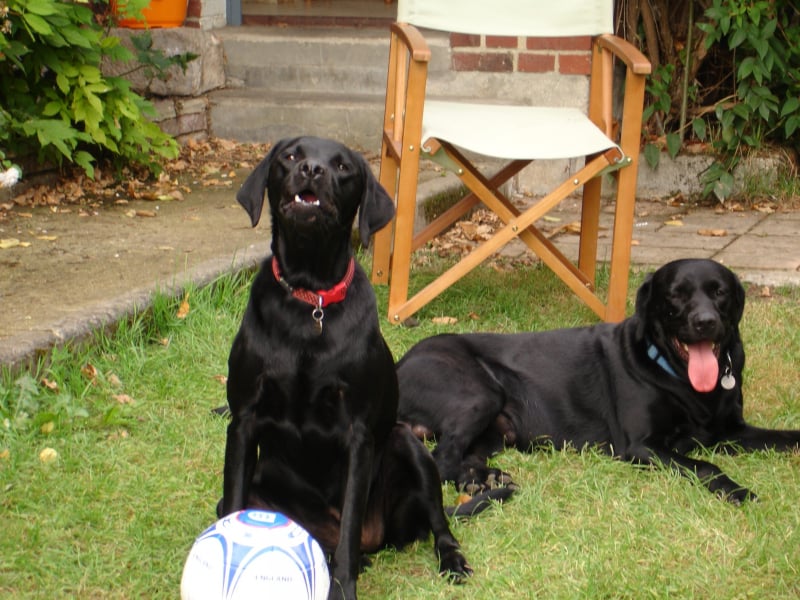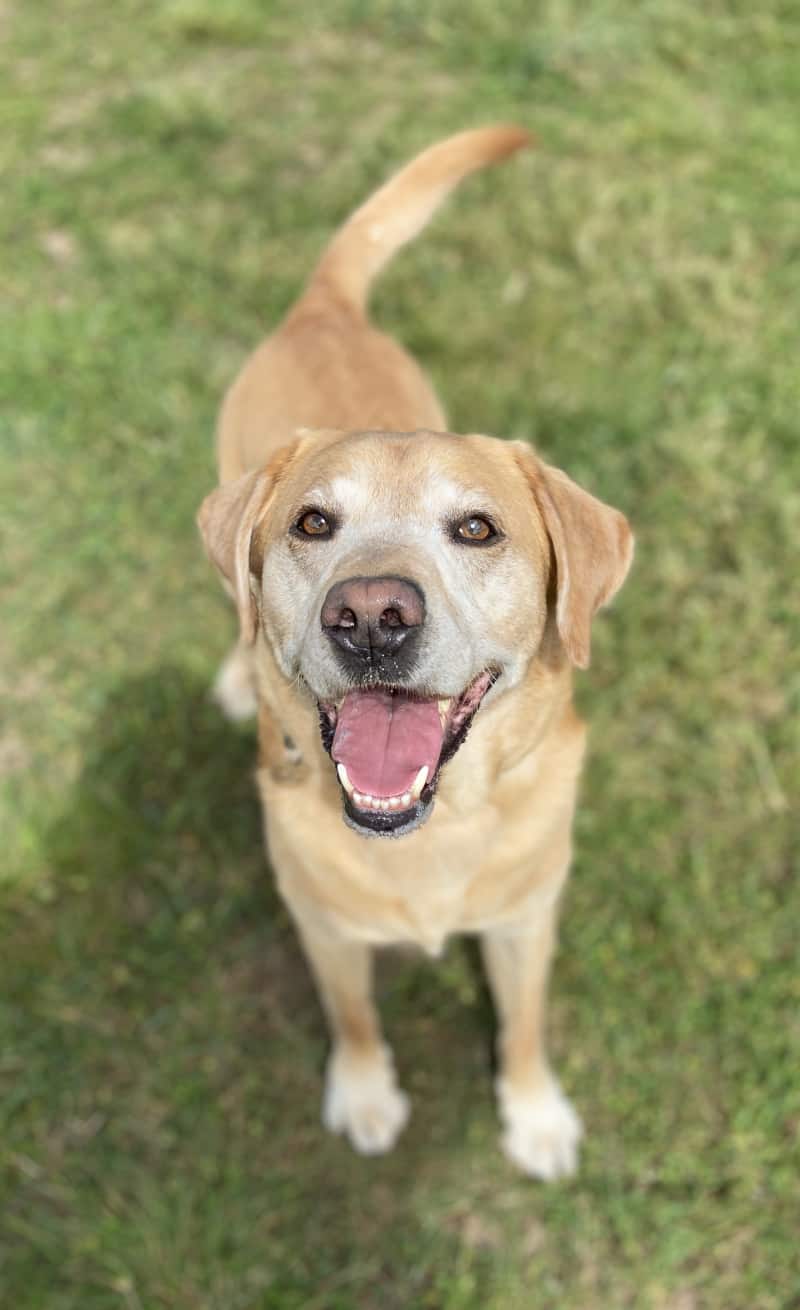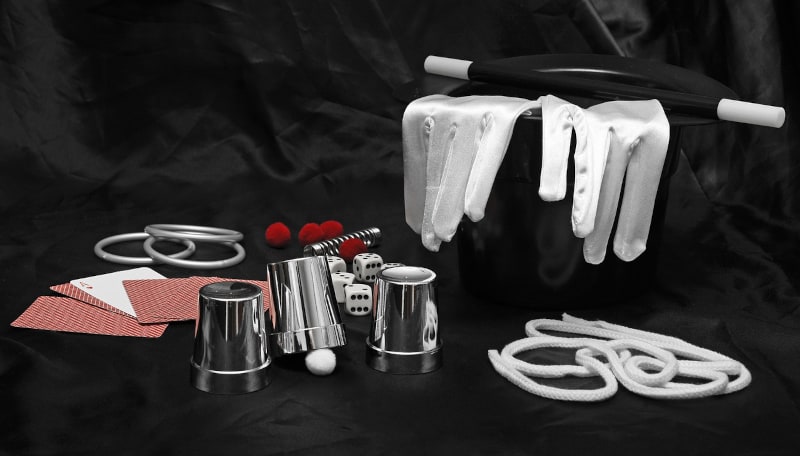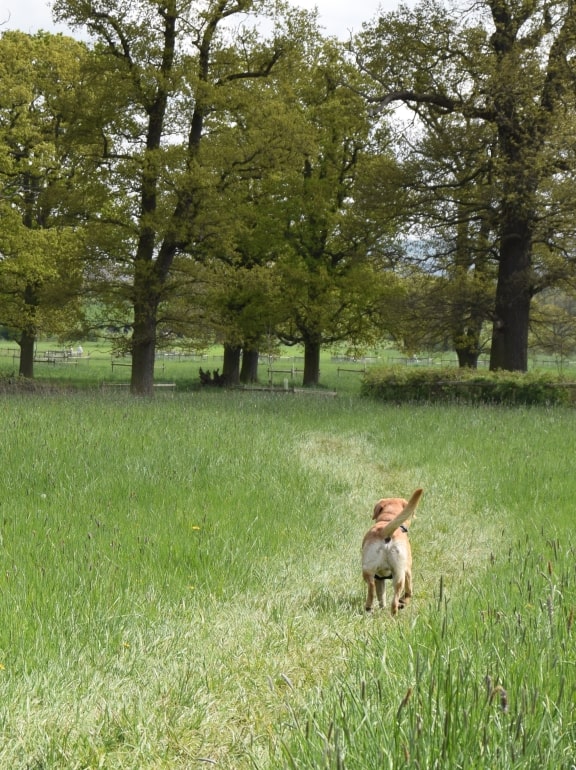Why do dogs bark?
Whether it is your own dog, one belonging to a neighbour or friend, or just one that you see while you are out and about, it’s hard to ignore a barking dog.
Depending on the context, it can be annoying, distracting, frustrating, upsetting, or just plain frightening.
And what strengthens these feelings is that very often we don’t understand the reasons for the barking. Nor, importantly, what we can do to stop the barking.
Our failure to comprehend barking causes, and their prevention, perhaps played a part in coining the term “barking mad”.
“If you say that someone is barking mad, you mean that they are insane or are acting very strangely.”
Collins Dictionary
So, do some of us have barking mad dogs?
Let’s examine the reasons why dogs bark. And the solutions. That is, how to stop dog barking.
Affiliate Disclaimer
1 Introduction – My Dog Doesn’t Bark!
You are not alone
For those of you with a barking dog and who are looking for reasons and solutions – I share your pain. This is what has motivated me to research and write this post.
And others share our pain too. Whilst writing this post I made a couple of online polls, one in a Facebook group and one in an online forum. Combining the results showed that 45.7% of dog owners either has or has had a dog that barks excessively.
Now, these were fairly small sample sizes. And one could argue that those using online groups and forums may not be representative of the general population of dog owners. Nonetheless, I was a little surprised to find that nearly half of the owners have experienced excessive dog barking.
Why Does My Dog Bark?
“Why does my dog bark?”
“My dog barks at everything.”
“Why does my dog bark at nothing?”
“What can I do to stop my dog barking?”
I used to hear and read comments like this all the time and, although I sympathised, I couldn’t empathise – our Labrador, Harvey, was completely silent!
I may even have tempted fate by saying, once or twice – “My Dog Doesn’t Bark!”
One Summer, my wife and I, together with Harvey, went on holiday to a lovely, quiet, isolated cottage in the Welsh countryside.

On a sunny afternoon, we sat out on the patio, enjoying some wine and nibbles, taking in the beautiful scenery …

… enjoying the peaceful surroundings and admiring the beautiful wildlife …

… watching the occasional Red Kite glide majestically overhead …

… and generally feeling pretty relaxed and content. Until …
WOOF! WOOF! WOOF! WOOF!
“Holy crap!”
WOOF! WOOF! WOOF! WOOF!
“You nearly gave me a heart attack!”
Harvey isn’t some Cujo-like, behemoth of a dog. He’s a very lovable Labrador.
But the power of this bark was immense. I didn’t just hear it – I felt it!
Combined with the shock factor, stemming from the fact that he had never before barked, it was quite an unpleasant experience.
What we found, in the minutes which followed, was that there was somebody knocking on the front door. We hadn’t heard them. But Harvey had!
Keep reading and I’ll outline some of the reasons why dogs bark. See if you can identify what caused Harvey to bark.

2 How Dogs Communicate
When we want to communicate with each other what do we do?
Well, typically, we talk.
And, because this is our primary means of communication, we tend to think that dogs’ primary means of communication is also verbal.
Guess what?
It isn’t!
The primary way in which dogs communicate is through the use of body language. They can, and do, also use scent and verbal communication but these are secondary.
Through the use of tail position and movement, ear and eye position, overall facial expressions, and body posture, dogs can convey a lot of information.
Other dogs are, usually, very good at receiving and understanding this information. Humans, both dog owners and non-owners, are typically not very good at it.
By way of illustration, what do you think a dog is telling you if his tail is wagging?
He must be happy. Right?
Not necessarily.
If the dog’s overall posture is rigid, with the body in a slightly crouched position, with his ears pinned back and staring eyes – he is probably not at all happy.
Sometimes, the body language can be really subtle. If you want to learn a little lot more then take a look at this video featuring a talk by Patricia McConnell, one of the leading experts in the field.
“That’s very interesting … but what has it got to do with barking dogs?” you may be thinking.
Well, the reason I’m telling you this is so that you understand that dogs don’t use barking just to ‘have a chat’. Their primary communication method is body language.
If your dog barks it’s because he is trying to tell you something. And, in his mind, it is likely to be something very important that requires your prompt attention.
3 Bark Analysis

Don’t worry, you haven’t got to find some paper and crayons before running off to find the nearest tree and start taking bark rubbings or anything like that!
Canine Cacophony
Before we move on to consider the different scenarios in which our dogs might bark, let’s take a moment to consider how we might describe the different barks – and so enable us to more easily distinguish between them.
Are we just hearing a canine cacophony? Or is there more to it?
Pitch
Pitch is the subjective perception of the frequency of sound. So, although high pitched sounds correlate with high frequency sounds (and, similarly, low pitch and low frequency) the pitch perception can be slightly different between individuals.
In terms of dog barks, when we refer to high pitch think in terms of your dog being hugely excited about the prospect of play. And for low pitch, think in terms of a guttural growl made by way of a warning.
Frequency
We can also draw information from how frequently barks are repeated, and at what rate. Is there a single bark and then silence? Or a series of barks with short intervals between?
4 Human Understanding of Barking

Would it surprise you if I told you that you may be more Dr Doolittle than you realise?
In a study by Hungarian ethologist, Péter Pongrácz, he found that humans listening to dog barks could determine whether the barking was aggressive, fearful, or playful.
In the tests that he conducted, the human participants were able to make the distinction between the different categories at a level significantly above random chance.
He concluded:
“Our theory is that the dog is a very special, man-created animal. It was shaped during many tens of thousands of years of domestication to live with people, so it’s not surprising that this type of communication should exist.”
Péter Pongrácz
How would you like to check your own ability to make the distinction?
Well, you can. Try the interactive test here: The Meaning of Dog Barks.
So, now that we know a little about how dogs communicate, with each other and with us, let’s have a look at some of the things that our dogs might try to tell us.
That is, why do dogs bark?
5 Alert Barking

Although scientists can’t agree on exactly when it happened, humans and dogs first formed a working relationship many thousands of years ago. You can read more about it in this article from the Smithsonian.
It is thought that the initial appeal to humans was that the dogs would clean up any scraps of food left lying around, thereby reducing the possibility of vermin problems.
However, man soon learned that dogs served another hugely valuable function. They would alert them to the approach of dangerous animals or competing tribes. This warning could be the difference between life and death.
And how did the dogs provide this alert?
That’s right – by barking.
So, for thousands of years dogs have been appreciated and rewarded for doing the very thing that we now want them to stop.
Or do we?
If you have a dog that does alert barking (often also referred to as territorial barking), keep in mind that there are many dog owners who would love to have a dog that provides an early warning of potential danger.
Yes, 99 times out of 100 it will be the postman, the window-cleaner, a neighbour going to work, or any number of other innocent individuals.
But, on that 1 time out of 100, when it is a burglar contemplating breaking in to your house to relieve you of your possessions, you’ll be glad of your dog’s warning.
And be even happier if you see that the barking has resulted in the burglar skulking away to reassess his options.OK, so if we think about it, we shouldn’t want our dogs to suddenly completely stop what they have been encouraged to do for thousands of years.
What we want to stop is excessive dog barking.
We’ll discuss how we do that later in the post.
It’s worth noting at this point that in a 2004 study undertaken by Sophia Yin and Sarah Richardson they found:
- Dogs are most likely to bark excessively when their owners are actually at home rather than away from home.
- Dogs are most likely to bark when they are inside the house rather than outside.
- The trigger for the barking is most likely to be a response to the appearance of new stimuli – for example, people walking by, unexpected sounds, or other dogs barking.
- The use of remote punishment, such as an electronic collar, had poor long-term effectiveness.
The study’s authors conclude:
“Because a majority of excessive barking occurs when the owner is home and thus available to reinforce alternate behaviors, because many excessive barkers bark at specific stimuli rather than out of non-specific boredom, and because remote punishment has low long-term efficacy, solutions to excessive barking should focus on helping owners understand the causes of barking and providing them with positive reinforcement shaping procedures that address the specific etiologies.”
Sophia Yin and Sarah Richardson
What Does Alert Barking Sound Like?
What you can expect to hear is :
- Low pitch barks
- Repeated in clusters of two to four
- Delivered at a quick pace
How to Stop Alert Barking
To jump ahead to the training section click here: Stop Alert Barking
6 Happy Barking

I know what you’re thinking. There is no such thing!
But, from your dog’s perspective, there are times when you just have to, vocally, express how happy or excited you are.
“You’re back! I’m so pleased to see you!”
Or:
“You’ve picked up the lead. That means a walk. Or an off-lead runabout. Or some play. Or training. I LOVE all of that stuff!!“
Or:
“There’s somebody outside. Do I need to warn the pack about the scary postman? No, wait … it’s one of my FAVOURITE people – they always give me lots of attention.“
You’ll notice that, in addition to barking, your dog will be quite active. He might run around in circles, run back and forth, jump up, and, of course, excitedly wag his tail.
This is your dog showing you that his excitement is so great that he is just about ready to explode!
What Does Happy Barking Sound Like?
What you can expect to hear is :
- High to medium pitch barks
- Typically only one or two at a time
- Delivered at a quick pace
How to Stop Happy Barking
To jump ahead to the training section click here: Stop Happy Barking
7 Attention Barking

A few years ago now (probably more than I care to remember!) there was a TV advertisement for headache tablets.
The ad featured a woman who was clearly having a very bad day. Countless jobs to do, TV blaring away, ‘phone ringing, and a young child making a simple request – over and over again.
“Mum can we have a rabbit?”
“Mum can we have a rabbit?”
“Mum can we have a rabbit?”
“Mum can we have a rabbit?”
“Mum can we have a rabbit?”
It’s called Pester Power. And it is immensely powerful – your mind feels as though the only way it can switch off the relentless onslaught is to concede!
Well, in the canine world Pester Power is known as Attention Barking.
Your dog may be craving attention for any number of reasons, such as:
- He wants to go for a walk.
- He wants to go outside in the garden.
- He wants something to eat.
- He wants to play.
The first time he has a particular desire he may bark. And then bark again.
What do you do?
“Oh, do you want a walk? OK”. And you proceed to take him for a walk.
So, what has that taught your dog?
It’s taught him that if he wants a walk and he barks you will take him for a walk!
That is, you have reinforced the barking behaviour. Simple Operant Conditioning.
The next time your dog wants a walk he will bark again. And if you don’t respond he may well continue to bark. For your dog a bark means “Can we go for a walk”.
Pretty soon you have your own canine version of the headache ad.
“Can we go for a walk”
“Can we go for a walk”
“Can we go for a walk”
“Can we go for a walk”
“Can we go for a walk”
What Does Attention Barking Sound Like?
What you can expect to hear is :
- High to medium pitch barks
- Typically only single barks
- Delivered with a pause between
How to Stop Attention Barking
To jump ahead to the training section click here: Stop Attention Barking
8 Anxiety Barking

Dogs are very social creatures.
And its not just with other dogs. They like human company too. Especially ‘their’ humans.
As a result, some dogs can become quite stressed when they are left alone.
This is likely to result in Anxiety Barking. This is part communication “I’m all alone and I don’t like it!” and partly to self-soothe.
Separation Anxiety doesn’t solely manifest itself in the form of barking. The affected dog may also urinate, defecate, vomit, drool, engage in destructive behaviour, pace, or even try to escape.
Some dogs become so frantic that they may even injure themselves in their attempts to escape.
Common causes include:
- Abandonment. A dog that has been abandoned, or left at a shelter, by his original owner is far more likely to develop separation anxiety than a dog that has been with the same family since he was a puppy.
- Family changes. Sudden, radical changes in the make-up of a family can be a factor. For example, the death of an elderly person, or somebody getting a job that necessitates moving away.
- House changes. Even moving house can be sufficient to bring on the problem.
- Schedule changes. If somebody that works part-time suddenly has to work full-time, meaning that their dog must spend more time alone, this could be a trigger. Or somebody that has been unemployed finding a job.
- Stopping in a boarding kennel for the first time.
What Does Anxiety Barking Sound Like?
What you can expect to hear is :
- High pitch barks, often accompanied by whining or howling
- Typically only single barks but a number of them
- Delivered with distinct pauses between
How to Stop Anxiety Barking
To jump ahead to the training section click here: Stop Anxiety Barking
9 Fear Barking

When we have a puppy we do our best to fully socialise them so that they aren’t frightened of the various things that they will encounter as adults.
Sometimes we miss things. Other times a negative experience can carry more weight than the socialisation.
They might be scared of other dogs of a particular type because a dog like that has attacked them previously. For example, if your dog is attacked by a Border Collie it is likely that he will view all Border Collies as potential threats.
Or they might be scared of the noise and flashes of light from fireworks.
They might even be scared of something seemingly innocuous like a fluffy kitten!
Whatever the reason, most dogs will be afraid of something.
And if a dog is afraid he has the classic ‘fight or flight’ options to help him deal with it. However, if the dog is somehow constrained (like being on a lead) then the ‘flight’ option is taken away. So, what does that leave?
Fight!
Dogs don’t generally want to fight each other. It’s a risky tactic that can involve serious injury for the parties involved.
So what happens is that the fearful dog will try to warn the other party (usually another dog, but sometimes a person) before a fight starts. They give this warning by … barking!
Unfortunately for us, if the warning is successful and a fight is avoided the dog is then more likely to bark the next time that he encounters a similar situation. It worked last time so it might work this time too. You can’t fault his logic!
And it gets worse …
As you might imagine, these experiences are stressful for your dog (and for you, too, probably). What you may not be aware of is that these stressful experiences ‘stack‘.
After a stressful experience, the dog’s stress hormones remain in his body for some time afterwards – this enables a faster response to threats following the initial one. If there is another incident the stress level becomes further elevated. And so on, and so on.
If the dog is continually exposed to stressful situations, without ever being able to fully reduce his stress levels, he is likely to suffer emotionally and physically.
What Does Fear Barking Sound Like?
What you can expect to hear is :
- Low pitch barks, possibly accompanied by snarling or growling
- A string of 3-4 barks
- Delivered in rapid succession
How to Stop Fear Barking
To jump ahead to the training section click here: Stop Fear Barking
10 Boredom Barking

Dogs are intelligent and active animals.
Consequently, they need both mental and physical stimulation.
If they don’t get sufficient of either for long periods of time then there is a good chance that they will become bored. And if they become bored there is a good chance that they will start to bark.
The barking can often be accompanied by other undesirable behaviours like chewing and digging.
Just imagine if you were put in a single room , or out in your back garden, with neither mental nor physical stimulation. For example:
- No television
- No devices (that’s no ‘phones, no tablets, no PCs)
- No reading material (no books, including ones in electronic format, no magazines or newspapers)
- No fitness equipment (no treadmills, rowing machines, weights)
- All you have is one manky old tennis ball!
How long before you would be bored?
I suspect many of you will have had palpitations at the very thought of not having your ‘phone!
Now, imagine that the above situation wasn’t a one-off. It was every day! How long before you’d fall apart?
Now think about what mental and physical stimulation you provide for your dog and long you leave him alone. Can you see how he might become bored?
What Does Boredom Barking Sound Like?
What you can expect to hear is :
- Moderate pitch barks
- Typically only single barks but in a long string (sometimes lasting for hours!)
- Delivered with distinct pauses between
How to Stop Boredom Barking
To jump ahead to the training section click here: Stop Boredom Barking
11 Play Barking

This isn’t typically the sort of barking that becomes excessive and causes a nuisance.
It’s your dog’s invitation to play. The invitation may be to you, other humans, or to dogs.
It’s often accompanied by a ‘play bow’, where the dog puts its front legs flat on the ground but with the rear end held high.
Your dog may also throw, or push, a favoured toy towards you to indicate the type of play that is being sought. “Throw the ball! Throw the ball!”
There may also be some side-to-side shuffling. A happy body language way of saying “Come on. Come on. I’m waiting to play!”
What Does Play Barking Sound Like?
What you can expect to hear is :
- Moderate pitch barks
- An endearing, slightly protracted bark
- If the ‘come play’ invitation is accepted, typically just a single bark
How to Stop Play Barking
To jump ahead to the training section click here: Stop Play Barking
12 Legal Consequences of Excessive Barking

OK, so you think that your dog barks excessively.
What is the legal position? What if your neighbours complain about nuisance barking?
Excessive Dog Barking – Relevant Legislation
Here in the UK (and, specifically, in England) the relevant legislation for noise nuisance, which is what excessive barking is classed as, is the Environmental Protection Act 1990.
Rather than contacting the police, it is usual for a complainant to contact the local council. The council must then establish whether there is a ‘statutory nuisance’ under the act.
For the noise, barking in our case, to count as a statutory nuisance it must:
- unreasonably and substantially interfere with the use or enjoyment of a home or other premises, or
- injure health or be likely to injure health
The council will initially serve an informal warning letter giving the person responsible the opportunity to voluntarily resolve the issue.
If the warning is ignored and it is established that there is statutory nuisance then the council will serve an abatement notice. This requires the person responsible to stop making the noise altogether or, possibly, to restrict it to certain times.
Failure to comply (*) can result in prosecution and (unlimited!) fines.
* For some reason, whenever I hear this phrase I always think of the ED-209 droid in Robocop!
The person responsible could be issued with a Criminal Behaviour Order. This could compel the individual to reduce the number of dogs that they own.
The fines can take the form of an initial lump sum and then further daily fines for each day that the failure to comply continues.
Take a look at this BBC News article for an example of both the type of nuisance that is being considered and the extent of the fines.
Abatement Notices – Factors Taken into Account
So, what is taken into account by councils in making their determinations? There is no set definition of nuisance barking but the following factors will be considered:
- The volume of the barking
- The duration of the barking
- When the barking takes place
Volume
In terms of volume, you may be interested to know that the Guinness World Record for the loudest bark by a dog is 113.1 decibels.
To give this some context, take a look at the noise section of the Dogs and Fireworks-Induced Stress post and, in particular, the table showing example sounds at various decibel levels.
Obviously, if your dog barks but it is at a low volume and nobody else can hear it then that isn’t going to be a problem.
Duration
In terms of duration, how long is too long?
If your dog barks for 15 seconds each day when the postman delivers your mail then that isn’t likely to cause any trouble. If it barks pretty much continuously throughout the day then that is likely to be a concern.
Time of Day
When is barking least likely to be tolerated?
Well, most people will be trying to go to sleep sometime between 11 pm and 7 am. If your dog is preventing them from getting to sleep, or is waking them up, during this time then that will be a problem.
Other factors
There will also be non-dog factors:
- How close are you to your neighbours’ property? (the volume will be less of an issue if the nearest neighbour is a mile away compared to neighbours close by in flats or apartments).
- What do your neighbours do? If your dog only barks during the day and your neighbours are out all day then it is less likely to be an issue. Whereas, if it is a young family with children that are trying to sleep, or if it is a shift worker, it is more likely to be an issue.
- What is your neighbour’s general disposition? Happy-go-lucky always looking to help others? Or grumpy-old-git always complaining about something? Some will happily turn up the TV, use earplugs, or try to tune out the barking. Others will sit waiting for the slightest whimper before ‘phoning the police emergency number!
13 How to Get Your Dog to Stop Barking

There are various approaches that can be taken to help stop your dog’s barking. The most appropriate one will depend upon your particular circumstances.
13.1 Stop Alert Barking
Be calm!
Be calm?! I can almost hear you shouting at the screen.
Seriously though, take a second to think about it from your dog’s perspective. In his mind, he is trying to protect his family by alerting them to the danger he has identified.
And the reason that you need to be calm is that if you are not you will find it very difficult not to bark instructions like “Quiet!”, “Shut Up!”, “Stop That [Choice of expletive] Barking!!”.
And guess what happens:
- These are unlikely to have been cue words that you have taught your dog to understand.
- So, he doesn’t know that he is being asked to do something (stop barking).
- He does know that the words are delivered rapidly at a loud volume.
- And he can tell from your body language that there is something wrong.
So, what conclusion should your dog draw from these observations?
Well, to him it looks like you are joining in with the alert barking!
… So there must definitely be some sort of threat.
… So he keeps barking.
But not too calm
Sometimes in dog training, it can be helpful to ignore undesirable behaviour.
This isn’t one of those times.
Rather than stop barking, your dog is likely to intensify his efforts in an attempt to get his message across before you fall victim to the unknown assailant.
Imagine that your partner had been yelling at you to warn you that you were about to disturb a hornet’s nest. Not a metaphoric stirring up of a hornet’s nest. A literal one.
Would they feel they need to continue yelling once you had acknowledged the warning? No.
And so it is with your dog. So, don’t ignore his warning. Acknowledge it (calmly).
Put yourself between your dog and the impending danger (assuming it is of the postman variety rather than an actual danger) and use calming words and gestures to indicate that you are now aware of the situation and have assessed that it is not, in fact, dangerous.
As before, when trying to avoid yelling at your dog, he won’t (yet) know the meaning of the words used but he will pick up on the calm tone and body language that you use.
This could be as simple as holding up the open palm of your hand while saying, in a calm tone, “OK, Harvey, thank you. Quiet.”.
Now, before you get your hopes up, this won’t somehow magically stop your dog from barking from this point forward.
It’s the same as any other form of dog training – you need to practice until such time as your dog understands.
Training to reduce barking
As noted above in the study by Sophia Yin and Sarah Richardson, the best approach involves using Positive Dog Training.
Now, you can try this approach when you spot the ‘danger’ before your dog does or, more usefully in the initial training stages, you can engineer ‘dangerous’ situations with the help of friends. A simple, unexpected (by your dog) knock at the door should suffice.
The training would go along the following lines:
- Have your dog’s favourite treats ready to dispense. Not any old treat, like some boring kibble. You need the big guns here, some warm chicken perhaps, whatever most motivates your dog.
- Your friend knocks on the door.
- Your dog barks to alert you to the danger.
- You put yourself between your dog and the door.
- You give your chosen calming cues. For example, hold your open palm up and say “OK, Harvey, thank you. Quiet.”
- As soon as your dog stops barking you immediately mark that point, with a clicker if you are familiar with them but a simple “Yes” from you in your best ‘Aren’t you a clever dog’ voice will suffice.
- Accompany the marking of the quiet with your dog’s favourite treat.
- The objective here is to have your dog associate being quiet, after giving his alert, with receiving his favourite treat and your obvious delight.
Remember, you want your dog to succeed at this. Success for your dog equates to less barking for you and your neighbours.
Therefore, it’s in your best interests to help your dog to succeed.
If you’ve rewarded a quiet period and you can see that your dog is thinking about barking again – DO SOMETHING!
Throw a treat behind him to distract him.
Ask him for another behaviour – sit, down, shake a paw. The requested behaviour itself is less important than the act of breaking the barking habit.
Walk with him to another room and have a quick game of tug.
You need to repeat this process, over and over, every time your dog barks. After a while, you should notice that the amount of time it takes for your dog to enter, and remain in, the quiet phase gets shorter and shorter.
Finally, keep in mind that we are not looking to prevent your dog from giving any alert barking.
What we want is an initial alert, acknowledgement of the alert by us, and then quiet from the dog.
That is, it is excessive barking that we are looking to prevent.
Beware self-rewarding situations
I’d like you to put yourself in your dog’s situation for a moment:
- What’s that lurking on the horizon?
- Oh no, it’s the scary postman again. (OK, he may not actually think of him as the postman but you get the general idea!).
- I need to warn the rest of the pack.
- Woof! Woof! Woof! Woof!
- Where is everybody? Can’t they hear my alert? We need to chase off the danger.
- Woof! Woof! Woof! Woof!
- Oh look, the scary postman is retreating. Result!
In the training section above we talked about rewards. Rewards that we provide.
However, dogs can also find other things rewarding. Things that they can provide for themselves.
In the scenario above, your dog has discovered that if he barks, and keeps barking, the scary postman will go away. Which is what your dog wanted (given that you hadn’t come to help him!).
His barking has resulted in the outcome that he wanted. That is, he has self-rewarded (no interaction with us). As a consequence, he is now more likely to repeat the barking behaviour in similar situations in the future.
You, therefore, need to prevent this from happening. You can either:
- Follow the training procedure outlined above.
- Or, for times when your dog is alone, make it physically impossible.
In relation to this last point there are a number of simple steps that can be taken:
- Closing the curtains or blinds to remove the visual stimulus for your dog.
- Another way of removing the visual stimulus is adhesive window frosting.
- Or moving the sofa or chair used to look out of the window.
- Or keeping him in a room where he doesn’t have access to a window where he is likely to see scary postmen and the like.
Similarly, you need to manage your dog’s behaviour if, when outside in the garden, he is inclined to bark at your neighbour’s dog (or at your neighbour!).
As with the postman scenario, if your dog is permitted to continue barking until the dog or neighbour goes away he will see this as a vindication for his barking. And so do it again the next time. And the next. And so on and so on.
The easiest way to manage this, at least until you have things under control, is to only let him out while you have him ‘on lead’ and have a distraction. This will prevent the scenario where he is able to race up and down the fence line barking and ignoring your attempts at recalling him.
You can then use your distraction, this could be a favourite toy or tennis ball, to transfer his focus away from the dog/neighbour. Ideally, you should have a toy that is solely reserved for this training in order to help your dog make the association.
13.2 Stop Happy Barking
Some of these approaches will be similar to those already mentioned.
Be calm!
We want to try to reduce our dog’s excitement level (or, at the very least, avoid raising it further).
So, when you arrive home, remain standing and calmly greet your dog with a simple, quiet, medium pitch, “Hello”.
If your dog jumps up then turn away from him and do not speak to him until he has ‘four on the floor’. This is a situation where you DO want to ignore the behaviour.
DO NOT bend down, ruffle his fur, and excitedly proclaim “Whooooo’s a good boy, then? Have you missed me? Have you? Huh? Huh? Have you?
Beware self-rewarding situations
If your dog barks in excitement when he sees his favourite (canine) playmate and starts to pull and lunge towards him, if you allow them to meet then that is a huge reward for that undesirable behaviour.
You should not allow him to greet the other dog in this manner. If he is calm (no barking and no pulling) he can greet. If he isn’t then you should avoid the meeting – even if that means turning around and going back the way you came.
Training to reduce barking
We can use the same Positive Dog Training method as outlined above for two approaches here:
- Train your dog to do something else instead. Such as going to fetch and hold a favourite tug toy. For example, Harvey loves his puller rings so we’re going to use these.
- Train a bark cue (yes, seriously).
The ‘fetch and hold’ approach is great for when you have guests arrive. What we want to achieve is whenever the doorbell rings your dog doesn’t think ‘Woohoo! Fun humans! I’m so excited!’ but instead ‘That’s my cue to fetch something. And if I do, good things will happen.’.
In terms of implementing Bark and Quiet cues I found the following video to be very helpful:
13.3 Stop Attention Barking
Stop rewarding unwanted behaviour
OK, first things first.
As you will have read in the description section for Attention Barking, there is a very real possibility that you have been inadvertently rewarding your dog for his barking.
This needs to stop. Now.
Do not give any attention to your dog while he is barking. If you do, you will just be making it harder in the long run.
Expectations
Secondly, you need to set your expectations.
As Dalton said in Roadhouse “It’ll get worse before it gets better.“
In all likelihood your dog’s response to you ignoring his attention barking will be to increase his efforts. After all, this approach has worked for him previously.
DO NOT give in until your dog stops barking.
If you persist in removing the reward then, eventually, your dog will make the connection and will stop barking.
Start rewarding wanted behaviour
Now, in addition to ignoring bad behaviour, we also want to start rewarding good behaviour. We want to make a new connection for your dog – being quiet brings rewards.
For example, if your dog is quiet around the time when you would normally go for a walk, reward him. Ideally, actually go for that walk BEFORE he thinks about barking.
Be consistent
And finally, you need to be consistent.
Consistency in applying the above is absolutely vital. You cannot weaken your resolve. If you do you will be destined to a life listening to the canine equivalent of:
“Mum can we have a rabbit?”
“It’s not what we do once in a while that shapes our lives. It’s what we do consistently.”
Anthony Robbins
Just to really force the point home …
Many dog owners who have been unsuccessful in implementing a particular training method will say something along the lines of “Yes, I tried that for a bit. It didn’t work!”
Tried it ?
For a bit ?
Frankly, that won’t cut it.
What would you think if you asked your child why they hadn’t completed their homework and they just said “I tried it for a bit.”?
Or if you paid a driving instructor to teach you how to drive and, after failing your driving test because the instructor hadn’t taught you all that you needed to know, they said “I tried it for a bit.”?
I finish this section with a quote for the Star Wars fans (but it applies equally to all of us!):
“Do … or do not. There is no try.
Yoda (Star Wars)
13.4 Stop Anxiety Barking
Counter-conditioning and Desensitisation
If the separation anxiety is fairly mild then counter-conditioning may be sufficient to resolve the problem.
What this means is that training is undertaken to change the dog’s anxious reaction to a trigger, like a person leaving the house, to a more desirable reaction like relaxation.
By helping the dog to associate pleasant things with the triggers he can, over time, learn that the these triggers are predictors of good things happening rather than something to be feared.
This training may take a considerable period of time. Depending on the dog, even 5 minutes of separation may be too much to take initially.
Some items that you may consider using as the ‘pleasant things’ for counter-conditioning include Lickimat for dogs, Lickimat Splash for dogs, Lickimat Slomo and Lickimat Wobble.
Another approach is desensitisation.
You start off leaving your dog for very short periods of time, possibly for just seconds initially, then return before your dog becomes too anxious. The periods of absence should be random rather than identical periods each time.
Consult a behaviourist
More severe cases will require a more detailed approach.
They may also require a consultation with your vet to obtain some medication to help your dog relax – in severe cases your dog may be too stressed to be able to focus on any training offered.
This is likely to be the most difficult to stop of all of the types of barking.
13.5 Stop Fear Barking
Reducing stress
In the description of fear barking, we discussed how your dog’s fearful encounters can lead to his stress levels ‘stacking‘. To reduce fear barking you need to reduce your dog’s stress levels.
“How do I do that?” you may ask.
- Protection
- Relaxation
- Fun!
- Medication
The first, and most important, thing to do is to stop the ‘stacking’. You must do your utmost to protect your dog from situations that he is fearful of.
If he regularly has fearful dog-to-dog confrontations in a particular location – don’t go there!
If he is scared of fluffy kittens and you see one approaching – turn around and go the other way!
The second thing to do is to help your dog to relax. This will help to lower the existing stress levels. You can achieve this in a number of ways.
- Slow-paced, calm walk. This is best ‘on-lead’ so that you retain control of your dog’s actions – no running off chasing the wildlife or ‘having a hoolie’ with his best friend!
- General training work (mental stimulation can be just as tiring for a dog as physical exertion).
- Scent work. Dogs have a remarkable sense of smell – it is so much better than a human’s that it is difficult to comprehend. As a result, a scent work session can be very mentally tiring for your dog.
- Canine massage. Many dogs love the calming effect of having a massage. And, as an added bonus, it helps you to bond with your dog and reduce your own stress levels.
If you haven’t tried canine massage before you can see a couple of example videos in the post on Canine Arthritis. Just scroll down a little to the ‘Massage’ section.
Thirdly, have fun with your dog. Playing with your dog will help him to relax. Do you know that good feeling that you get after exercising? Same thing here – you are helping your dog to release the ‘happy hormones’ to combat the stress.
And, fourthly, consider using the various products that are available to help your dog cope with his elevated stress levels.
Dog Appeasing Pheromone treatments may help dogs to cope with fear. It is believed that the smell of these pheromones has a calming effect on dogs. These come in the form of a collar or a plug-in diffuser.
Pressure clothing can also help. Many dogs find it comforting to wear tight-fitting garments. There are various options here including Thundershirts and wraps.
Counter-conditioning
I realise that you may be keen to move on to this training stage. However, my recommendation would be to spend at least a week on the de-stressing part above first. If your dog’s stress levels are too high it will hamper his ability to focus and learn.
As in the anxiety barking section, what we are looking to do here is to change your dog’s response to a certain stimulus.
So, if your dog is scared of fluffy kittens, every time that he sees one you give him a reward. And it needs to be a high-value reward! We’re talking warm chicken stream-fed as a treat. Or getting to carry his favourite toy. Find what motivates your dog!
Eventually, your dog makes a good connection with the stimulus rather than a bad one. Instead of fearful barking, he looks to you for his treat. Success!
Desensitisation
OK, I’ll give you fair warning, this approach works … but it requires a great deal of time and patience (even more so than other types of training).
It’s all about gradually building up your dog’s exposure to the fear stimulus. You always want to be working at a distance that is (just) sufficiently far away for your dog not to react.
For example, if your dog reacts to the dreaded fluffy kitten at a distance of 50 metres then you start the training by keeping your dog at 51 metres away and rewarding him for not reacting (counter-conditioning).
You then gradually move a little closer, paying close attention to your dog’s demeanor. Is he still happy and relaxed? Or is he staring straight at the fluffy kitten, his body rigid and his hackles up?
Do you remember what we said was the primary means of communication for dogs? That’s right – body language. So, now is your chance to learn another language! Take note of your dog’s body language while you complete this training – and act accordingly.
If he doesn’t react then you reward him. If he does then you’ve gone too far and need to move back a little. Rinse and repeat, gradually moving ever closer to the fear stimulus.
Do not attempt to complete this process quickly or you risk losing any benefits you may have gained. It must be done gradually – depending on the particular circumstances this can take months of training sessions.
You may wish to consider enlisting a helper for your training. Your helper can be, or can influence, the fear stimulus – helping you to maintain the desired distance. It can be tricky on your own if you are aiming for 51 metres but the fluffy kitten keeps advancing!
13.6 Stop Boredom Barking
You need to focus on making sure that your dog has sufficient exercise and mental stimulation.
Or ensure that the periods that he is left alone are not too long.
Or, better yet, both!
Can you fit in a morning walk before going to work? Even a 20-30 minute walk could make a big difference.
Don’t attempt to rush the walk thinking that you have to reach a certain distance. Quality is more important than quantity – let your dog do lots of sniffing, let him observe other people and dogs … let him be a dog!
Or, what about some games in the back garden? Fetch, tug-of-war, find it (hide a toy or treats and ask your dog to find them).
Or, some training? Dogs love learning new things. Draw up a list of cues that you would like to teach your dog and … teach him.
As with the walks, don’t try to rush the training. Take your time and be patient.
If your dog is struggling with something – take a break (play for a few minutes), if it is still proving difficult then mark it down for another day and do something else for a few minutes that your dog does well (even if it is just ‘sit’) – finish on a positive!
Try using interactive toys.
You’ll find plenty of these on Amazon. Some good options are:
- Treat dispenser (Basic). Chew-resistant toy with a unique shape that gives erratic movement (and more fun!).
- Treat dispenser (High-end). Looking for something really special? How about a treat dispenser that has a Wi-Fi remote camera with 2-way audio and night vision!
- Classic Kong. Is it a toy or a treat dispenser? It’s both and dogs love them. Search the internet for Kong-stuffing recipes.
- Treat ball. Fill the ball with treats – encourage your dog to play with his food!
- Nylabone chew. Entertainment for your dog and beneficial for his teeth too.
If you are leaving your dog to play by himself be wary of giving him any toys which he might be able to swallow and choke on.
Other, third-party, options are doggy daycare or a dog walker.

Harvey absolutely LOVES Darren the dog walker. This is exactly what you want – physical and mental stimulation that your dog enjoys.
If you happen to live in the Worcester (UK) area then I’d highly recommend the dog walking service that we use. The service is provided by Hillview Canine Centre.
Similarly, if you are looking for mental stimulation activities, you can try the dog gym (and agility, and flyball) at Lisa Jackson Dog Training.
If cost is an issue you could look for a volunteer dog walker. These are people who don’t have their own dog (perhaps they live in rented accommodation where pets are not allowed) but would like to be able to walk one.
Obviously, you would need to do some ‘due diligence’ work, as you would for a professional dog walker. Ask for two or three references from people who are happy with the service.
For dogs that are left outside to bark … bring your dog indoors. Many dogs that are bored barkers outside are perfectly happy indoors and will quietly await your return.
13.7 Stop Play Barking
It’s unlikely that play barking will be excessive enough to become a nuisance.
If you do find that your dog is a little too demanding sometimes then you might want to teach the ‘All done’ cue. We use this with Harvey and it works really well.
Whenever you finish a particular activity with your dog, like the end of a play session or training session, say “All done” and hold up two open palms (showing your dog that you have nothing more for them in your hands).
Dogs are excellent at making associations and after doing this for a while your dog will come to realise that these cues signal the end of whatever activity it was that you were doing.
In this way, you aren’t ignoring your dog’s invitation to play (potentially causing frustration), you’re saying that the play session has finished for now.
13.8 Distraction Techniques

How do magicians manage to fool us with their magic tricks?
Distraction (misdirection, deception, smoke and mirrors).
Let’s consider how this technique can help us with training our dogs.
In addition to the various approaches outlined above, it can be useful to have a mechanism for redirecting your dog’s attention to you and away from something undesirable, like barking.
What we want is a response so that is so strong and automatic that our dog will immediately react rather than giving any further thought to the undesirable activity.
The technique is known as ‘Positive Interruption’ but it has been given various cue words, depending on who is undertaking or advising on the training.
You want something fairly short – to help your dog understand it – and something intuitive – so that you will remember it. With Harvey I’ve used “What’s this?” (and I know that snowbunny on the My Labrador Friends forum uses “Scatter” for her version).
Let’s look at how we might train such a behaviour.
- Start in a no-distraction setting with your dog looking at you – we don’t want anything challenging to start with. In your best, cheery, training voice say your chosen cue word, like “What’s this?”, and immediately give your dog a very high-value treat. Keep repeating until you are happy that your dog knows that something good always follows you saying your cue.
- Now practice in a low-distraction setting – your dog isn’t looking at you but isn’t doing anything hugely exciting. Use your cue in your best ‘squeaky toy’ voice. Your dog should immediately look round at you and come for his high-value treat. If he doesn’t return to step 1 for a while longer.
- Now add a slightly more challenging distraction and repeat the cue delivery and reward process.
- Gradually add more and more challenging distractions (if there is a failure then you’ve pushed too far too fast – go back a step).
- Move outside. The addition of all the scents that a dog can detect outside will make this much more challenging for him. Continue with the cue delivery and reward (you may get some funny looks but who cares – do what you’ve got to do!).
- Showtime! This is what we’ve been working towards. The next time that your dog starts barking – use your cue (make sure you are prepared and have the high-value treats to hand – perhaps in a bowl somewhere easily to hand).
Don’t just use the cue for barking alone now – practice in other, lower distraction, scenarios too in order to help keep the response strong.
Now, some of you may be thinking at this point that we are rewarding the dog for doing the very thing that we are trying to discourage – barking. After all, the sequence may appear to be:
- Dog barks
- Dog gets a high-value treat
However, that’s not the case. The sequence is actually:
- Dog barks
- Owner delivers cue
- Dog gets a high-value treat
The thing that is being rewarded is the thing that happened immediately before the treat is given – the cue. That is, the dog is being rewarded for responding to the cue that we have trained.
14 How Not to Get Your Dog to Stop Barking
Some people choose not to undertake any training with their dog to reduce excessive barking.
They prefer the route that is quick and easy for them, involving no effort whatsoever, regardless of the consequences for their dog.
They look to make use of various ‘anti-bark’ devices. Things like collars that they can use to give an electric shock to their dog if it dares to bark. Or emit an unpleasant sound. Or collars that spray substances on the dog that the dog finds unpleasant.
And the ultimate irony of the lazy person’s approach to dealing with barking? Studies have shown that it has very limited effectiveness in the long term.
I’ve left the worst for last … debarking.
This barbaric act involves the surgical removal of the dog’s vocal cords. Just for barking! If your baby cries all night and keeps you awake would you book it in for an operation to remove its vocal cords?
Don’t do it. Please. Just don’t.
15 Frequently Asked Questions
Do Dogs Enjoy Barking?
Barking is a form of canine communication. If your dog barks he is trying to communicate with you (or somebody else, or another dog). So, barking in itself is not enjoyable but your dog might be trying to tell you that he is happy to see you or perhaps telling another dog that he wants to play.
Why do Dogs Bark for no Reason?
They don’t! The reason may not be immediately apparent, or may not seem to you to be justified, but rest assured there is one. If a dog is left outside, alone, for long periods of time, he may bark out of boredom, loneliness, or just pure frustration. So, look for the reason and then help your dog get to a position where he doesn’t need to bark.
How do you Stop a Dog from Barking?
The first thing to do is to identify what it is that is causing your dog to bark. Only then can you tackle the barking. For example, if your dog is alert barking (warning you that there is a potential danger) then establish what it is that is causing him to feel that he needs to warn you. You can then take training measures to target this specific issue.
Is Excessive Barking Against the Law?
This will depend upon your country of residence (and possibly even a region within that country). And, rather than being specifically targeted at excessive barking, it is likely to be general legislation targeting anti-social noise levels. For example, in the UK it is the Environmental Protection Act 1990. If the relevant body establishes that the noise level is excessive they will require the person responsible to stop it – if they don’t then they can be prosecuted and fines can be imposed.
What is the Best Device to Stop a Dog Barking?
Research has shown that although devices like anti-bark collars may have initial success in stopping a dog from barking, their long-term success is limited. Furthermore, in many countries, they are considered to be cruel and have been made illegal. A better approach is to make use of positive dog training methods.
What is Debarking?
It’s a surgical procedure involving the removal of tissue from the vocal cords in order to make it physically impossible for a dog to bark. It is physically painful and mentally distressing for the dog. Imagine seeing a loved one in imminent danger and not being able to shout out to them, or being able to tell them just how much you love them when they return home. Fortunately, many countries have made the practice illegal.
16 Acknowledgements
And …
And snowbunny and Cath from the My Labrador Friends forum
17 The End

I hope that you’ve enjoyed this post.
Feel free to navigate around the site to see if there is anything else that may be of interest to you.
If you liked this post please share it. Thank you 🙂
If you’d like a heads-up when the next post is issued sign-up to the Richie’s Room Newsletter.
And, if you’d like to add a comment that would be great too – you can do that below.
Feel free to use the comments section to give details of your own experiences of what worked and what didn’t for your barking dog.
And, finally, in the introduction, I asked you to think about what sort of barking Harvey had exhibited when he first barked. Did you identify what it was? Let me know in the comments.
Very informative article! Keep sharing.
Thanks Anoop. Glad that you enjoyed it.
I am not a dog owner, but we have many dogs in our neighborhood. I didn’t realize there were so many types of barks! This article is a gold mine for dog owners to help identify their own dog’s barks and specific ways to help stop each type.
I think it is important to acknowledge, as you shared, that this is the way dogs communicate and there is most often a reason they are barking.
I am frequently outside, so this has me wanting to pay closer attention to the types of barks I hear. I have definitely had many dogs do the ‘alert’ bark as we walk by their yard.
To answer your question, I think Harvey was giving an ‘alert’ bark. He heard someone knocking at the door and was potentially concerned that it was a scary thing and wanted to let you know!
Thanks for sharing a thorough and information-packed article!
Thanks for your feedback Heidi, much appreciated.
And you are spot on – Harvey was, indeed, alert barking.
People actually do debarking?! That’s craziness!!
What’s the best type of positive dog training you’d recommend for people to help stop their dogs barking at the wrong time Richie?
Hey Mike,
Yes, people actually do debarking. It’s very sad.
What do you consider to be “barking at the wrong time”? What triggers the barking? You need to identify the reason first and then you can implement the appropriate solution.
That was an incredible amount of detailed information, I can’t say I was expecting to learn so much. Great post
Thank you. I’m happy that I was able to pass on some information.
I have 3 dogs at home for 6 years already! I’ve learned many things since I have them. Thanks for sharing this post. I learn many stuffs from this xxx
Hi Merry. I’m glad that I was able to share some useful information with you.
Okay! This was some deep, information filled post. Learnt a lot of things from this post!
Thanks Vybav. Always good to learn new things.
Wow what a fantastic read. I learnt so much from this and I never had considered thinking about all the different reasons why they bark – apart from the obvious!
Roni
Hi Roni. Thank you, I’m glad you found it useful.
My beloved childhood dog was not much of a barker but if she did it was whenever she saw a squirrel. She barked only twice at other people as she (rightly so it turns out) did not trust them. Great informative post!
Hi Molly. Thanks for the positive feedback.
This article is both informative and interesting. I’ve never actually thought about why dogs bark as I’m not a dog owner but I really enjoyed this post.
Hi Alisha. Thanks for your comment – I’m glad that you enjoyed the post.
This is such an interesting and useful post to share for dog owners. Thank you for sharing.
Lauren
Hi Lauren. Thank you, much appreciated.
Harvey is absolutely beautiful, what a cutie! I never really gave much thought as to why dogs bark as our last dog, an Akita, was completely silent with the exception of the occasional cry when he was left alone. Despite having owned dogs, I had no idea there could be so many reasons that a dog would bark and it is really useful to learn more about this – especially as I’m hoping to get a dog again in the future!
Thanks, Ellie. Yes, we think so too – we were very fortunate to get him. Here’s hoping you get your new dog soon.
I guess becuase I have never owned a dog I havent actually asked myself this question! But this is super interesting, thanks for sharing!
Amber – The Unpredicted Page
Thanks, Amber. Hopefully some of it will stick with you for when you do get your own dog.
Goodness, I had no idea about the science behind barking. We don’t have dogs but some of our neighbours do and their dogs bark late at night, which is a little annoying. I think I have a better understanding of why now though – thank you for such in informative post! Lisa
Hi Lisa, thanks for your feedback. Glad that you can perhaps now see things from the dogs’ perspective – it doesn’t stop it being annoying though, unfortunately 🙂 How receptive do you think your neighbours would be to trying to do something about the barking? (Tread carefully – not everybody appreciates advice, no matter how well-intentioned).
This is such a great and informative post. I did not know the science behind as to why dogs bark. Thanks so much for sharing!
Thanks for the feedback, Charity. Much appreciated.
Such an informative and useful post. I’ve wondered why my neighbour’s dog sometimes bark at me, and sometimes it wants me to pet him, lol. Your article gave answers to some of my thoughts! 😀
Thank you for sharing this.
Hey Alexandra. I’m glad that you found the article useful. Thanks for your feedback.
My dog barks a LOT. And we pretty much understand each of his barks now. Especially his “I want food” bark haha! Great post!
Hey Jenny. Thanks for your feedback. What sort of dog do you have? How old is he?
Great post! I feel like I know why my dog is barking for the most part, but there are still times where I’m like “I have no idea what’s happening in her head.” haha This was very informative. Thank you!
Hi. Thanks for your comment. I’m pleased that you found the post useful.
Wow! I never knew there were THAT many forms of barking. My pup is on the quieter side, but he lets me know when he needs something. This was so informative. Debarking, thats just horrifying…I didn’t know this was something people actually do. Thank you for this writing!
Hi Kat, thanks for commenting. Yeah, our dogs are actually better at communicating than we give them credit for. As for debarking … well, it’s a poor reflection on those that do it.
I don’t have a dog but I really enjoyed your post and especially your pictures. Harvey is adorable…If I had a dog, I think it would be a lab. Thanks for an interesting and informative post.
Hi there. I’m glad that you enjoyed the post (especially as someone that doesn’t have a dog). Yes, Harvey is adorable – we’ve been very lucky.
I can tell that you put a lot of hard work into this blog post. It has taught me some new things about dogs. After reading this I hope to have a better understanding of my own dog. I will have to come back to your website to read more of your excellent writing pieces.
Hi Clara. I’m glad that the post has helped your understanding of your own dog. Do, please, come back and read further articles.
Wow! You have worked out in it so well. I always adored the way my pet barks when I arrive back from work and it generates comfort to my soul. Absolutely in love with this post. Thanks for sharing this insight.
Hi Sangeeta. Thanks for your feedback, I really appreciate it. Yes, you can’t beat that feeling that you get when you return home and your dog greets you.
Thank you for these interesting reasons! We had a dog that would bark as soon as the front door was touched, but the current puppy doesn’t bark at all. He cries a lot though, especially when you leave him on his own. Do you have any advice for attachment issues?
Em x
Hi Em. Thanks for your comment, much appreciated. How old is your puppy? How long is he usually left for? Where is he left? (Apologies for the interrogation – just trying to get some background!)
This was a really interesting post so thank you for sharing! Definitely lots of stuff here to bare in mind when i’ve hopefully got a dog one day!
Thank you, Hannah. Don’t worry, “one day” will soon arrive and you’ll wonder how you ever got along without a dog!
It is interesting how different animals make different sounds. It is their way of communicating but there are different emotions behind it. There is definitely a difference between a happy bark and an alerting bark. It makes sense that dogs bark more when their owners are at home. That is guaranteed attention lol! Thanks for sharing these facts!
Nancy ✨
Nancy, thank you very much for your comment. You are absolutely right, attention is certainly a factor.
Having lived in a house surrounded on all sides by barking dogs, I’ve often asked this question, usually with other unsavory words thrown in … While I’m still not likely to own a dog any time soon, this is good information to have.
Wow, one barking dog can be irritating, but to be surrounded by them must have been hugely frustrating. Hopefully, the article will have confirmed that it isn’t really the fault of the dog but of the [unsavoury word] owner. Thanks for your input Mrs P&P.
This is so informative – thanks for this! Our dog keeps barking at anything, even with the people she usually sees in our neighborhood. Probably because she’s used to staying home. Nice info on the types of barks and how to identify them!
Hi Queenie. Thank you – I’m glad that you found it useful.
Richie, this was an awesome article! Harvey is absolutely precious and that countryside literally took my breath away. Oh my goodness – what a glorious time that must have been for you and your family!
I love dogs, but as you mentioned in this article, a dog’s bark can be very jarring. It gets your attention, which is great, but sometimes, it can be excessive and upsetting. Dogs are excellent protectors so their instincts tell them, “I must alert my family!” Some people go overboard disciplining their dogs for barking, which to me, isn’t a good thing. We just need them to know when it’s okay and when we’d rather they didn’t.
You’re absolutely right – a dog barking is simply their way of trying to communicate with us. We do need to be paying attention. 🙂
I love how you laid out the various types of barking, what they mean, and how to help stop them excessively. Great tips that will help every dog parent out there. Thank you for sharing your love of our beloved pets! ♥
Hi Holly. Thank you very much for your kind words. You clearly know dogs and their behaviours very well, thanks for sharing your thoughts.
Great post Richie! My dog is VERY vocal. She definitely does the alert barking as well as the happy and play barking. She gets so excited it’s like she can’t seem to help herself sometimes! I have been trying many of the methods you mentioned with some success, but I think the real trouble is a lack of consistently between me and my partner. We both have very different takes on dog parenting unfortunately. 🤷♀️
Thank you, Clarissa. Yeah, some dogs can become very excited, both when concerned about something but also when very happy, too. Sounds like you have a training saboteur in your house! 🙂
This was such an informative read! I started reading around about dog barking and behaviours but sometimes they were too vague or not helpful enough, but this was very detailed and pleasant to read!
I remember when we first moved house when I was younger and our two dogs started barking a lot at home when we left and to be honest never considered that it was just an answer to being left alone in a new space.
Thank you so much for sharing this and all the helpful tips! 🙂
Hi Christina. Thank you very much for your feedback. I’m glad that you found the post to be informative.
Such an informative post – I’ve always wondered why some dogs bark more than others, for example, one of my dogs will bark when he’s greeting me whereas the other two dogs I have don’t. It’s interesting to read all the different reasons why a dog barks.
Hi Bethany. Yes, it gives you a different perspective when you think of the reasons that a dog may be barking.
Such an interesting post to read. I have learned so much about the reasons why a dog would bark. Thank you for sharing.
Thanks very much for your feedback, Charlie. It is greatly appreciated.